|
Monastery
of St. Moses the Abyssinian: Geography and History: The
ancient Syrian monastery of St. Moses the Abyssinian
(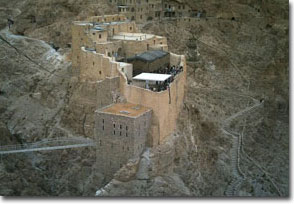 Deir Mar Musa el-Habashi) overlooks a harsh
valley in the mountains east of the small town
of Nabk, 80 km north of Damascus. It is about
1320 meters above sea level. Deir Mar Musa el-Habashi) overlooks a harsh
valley in the mountains east of the small town
of Nabk, 80 km north of Damascus. It is about
1320 meters above sea level.
Prehistoric
hunters and shepherds first inhabited the area
around the monastery, attracted by the natural
cisterns and pastures, ideal for herding goats.
Perhaps the Romans or Palmiriens built a watchtower
here. Christian hermits later used the cave
for meditation and, thus, created the first
small monastic center.
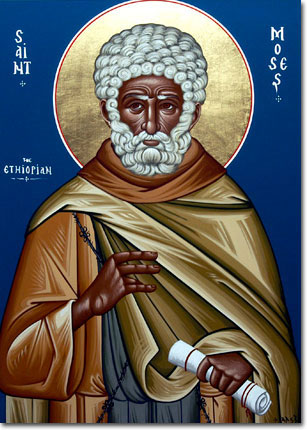 According to local
tradition, St. Moses the Abyssinian was the
son of an Ethiopian king. He refused to accept
the crown, honours and marriage. Instead he
looked towards the Kingdom of God. He travelled
to Egypt and then to the Holy Land. He later
lived as a monk in Qara, Syria and then as a
hermit in the valley where the monastery is
now situated and was martyred by Byzantine soldiers.
Tradition says that his family took his body
but a miracle separated the thumb of his right
hand and it was left as a relic – it is now
conserved in the Syrian church of Nabk. According to local
tradition, St. Moses the Abyssinian was the
son of an Ethiopian king. He refused to accept
the crown, honours and marriage. Instead he
looked towards the Kingdom of God. He travelled
to Egypt and then to the Holy Land. He later
lived as a monk in Qara, Syria and then as a
hermit in the valley where the monastery is
now situated and was martyred by Byzantine soldiers.
Tradition says that his family took his body
but a miracle separated the thumb of his right
hand and it was left as a relic – it is now
conserved in the Syrian church of Nabk.
From archaeological and historical evidence,
we know that the monastery of St. Moses existed
from the middle of the 6th century and belonged
to the Syrian Antiochian Rite. The present monastic
church was built in the Islamic year 450 (1058
AD), according to Arabic inscriptions on the
walls, which begin with the words: "In the name
of God the Merciful, the Compassionate".
The frescoes in the church date from the
11th and 12th centuries.
In the 15th
century the monastery was partially rebuilt
and enlarged. The monastery was abandoned in
the first half of the 19th century and slowly
fell into ruin. Nevertheless, it remained in
the ownership of the Syrian Catholic Diocese
of Homs, Hama and Nabk. The inhabitants of Nabk
continued to visit the monastery with devotion
and the local parish struggled to maintain it.
In 1984, restoration work began through
a common initiative of the Syrian State, the
local Church and a group of Arab and European
volunteers. The restoration of the monastery
building was completed in 1994 thanks to co-operation
between the Italian and Syrian States. This
Italian and Syrian school for restoration of
frescoes was created at Deir Mar Musa in 1989
and will complete the restoration of the frescoes
in the context of Syrian European co-operation. 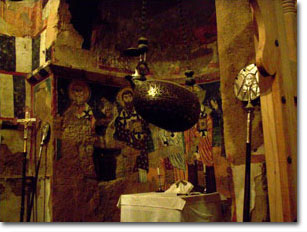 The Church and Frescoes of Deir Mar
Musa: The church of the monastery was
built in 1058 AD. It is a square of about 10*10-meters
and divided into two sections. The larger section
is a nave, with two aisles, illuminated by a
high eastern window. The second section is the
sanctuary containing the altar and the apse;
it is separated from the rest of the church
by a stone and wooden chancel screen. The Church and Frescoes of Deir Mar
Musa: The church of the monastery was
built in 1058 AD. It is a square of about 10*10-meters
and divided into two sections. The larger section
is a nave, with two aisles, illuminated by a
high eastern window. The second section is the
sanctuary containing the altar and the apse;
it is separated from the rest of the church
by a stone and wooden chancel screen.
To date, three layers of frescoes have been
revealed in the church. The first layer is from
the middle of the 11th century AD, the second
from the end of the 11th century, and the third
from the end of the 12th or the beginning of
the 13th century.
The images of the
most recent layer are fairly complete, and comprise
of two integrated iconographic cycles. The first
– and largest – cycle focuses on the dimension
of sacred history. The second, in the sanctuary,
represents the Mystery of the eternal and present
Instant.
The first image begins with
the image of the Annunciation. Gabriel stands
on the north side of the east window and the
Virgin Mary stands on the south; the Immanuel,
the infant Jesus, the sun of Justice, rises
above. (This image was destroyed, together with
other images in 1983, but has been partially
reconstructed out of pieces).
Beneath
the window, Jesus Christ wit apostles and evangelists
inaugurates the time of the Church, which receives
sustenance from the monastery of the Temple,
the Holy of Holiest. The nave of the church
is decorated with saints: females on the arches
and males on the pillars.
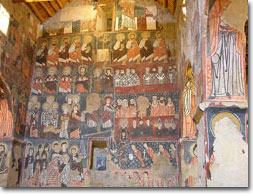 The four evangelists
are painted above the four central pillars.
They look upwards to a heavenly page which they
copy with Syriac letters in their Gospels. Six
martyred saints, painted as knights, on the
highest part of the nave, ride towards the East
fighting the good jihad of faith. The four evangelists
are painted above the four central pillars.
They look upwards to a heavenly page which they
copy with Syriac letters in their Gospels. Six
martyred saints, painted as knights, on the
highest part of the nave, ride towards the East
fighting the good jihad of faith.
The
second cycle; that of the actuality of the Mystery;
starts from the door of the Temple. The ten
virgins of the Gospel of Matthew 25 were painted
on the external face of the stone-part of the
screen, at the door to the sacred space of the
altar. Very little remains of this painting
but it has been partially reconstructed to show
that fie of the virgins had lights burning in
their right hands and five had extinguished
lights in their left hands.
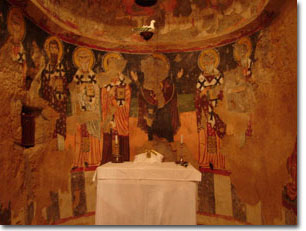 Behind the
altar stands the Holy Virgin, her Child sitting
on the throne of her womb. Around her stand
the Fathers of the Church. In the semi-dome
of the apse, above the altar, we can still see
something of the representation of Christ as
Son of Man, on his throne and surrounded by
cherubim. Mary, the mother of the Savior, and
John the Baptist are painted in the large arc
close to the throne, to act as intercessors. Behind the
altar stands the Holy Virgin, her Child sitting
on the throne of her womb. Around her stand
the Fathers of the Church. In the semi-dome
of the apse, above the altar, we can still see
something of the representation of Christ as
Son of Man, on his throne and surrounded by
cherubim. Mary, the mother of the Savior, and
John the Baptist are painted in the large arc
close to the throne, to act as intercessors.
The two cycles, one of history and one of
sacrament, are linked together by a representation
of the final judgment on the west wall of the
nave. The top of the fresco is lost but probably
represented Christ in his glory giving Peter
the keys to the Kingdom. (Peter is still visible,
standing on the right side, with Paul to the
left.)
Beneath the west window, is the
cross with the symbols of passion of Jesus:
nails, ladders, and the crown of thorns. On
the top of the throne, painted in the oriental
fashion with cushions and carpets, is the white
shroud, symbol of his resurrection from the
tomb. Sitting to the left and right of the throne
are ten apostles and evangelists who act as
judges. With Peter and Paul, they complete the
number of twelve.
 The rest of the representation
is divided between the right (Paradise) and
left (Hell). In the Paradise, beneath the throne,
Adam and Eve pray for all their children. Beside
them, the saved people are in the embrace of
the Virgin Mary, Abraham, Isaac and Jacob. Beneath
them two angels play the trumpets of judgment,
and the Prophets, Moses with Elijah, and, David
with Solomon, stand together with the Fathers
of the Church. A niche, which probably held
the relic of St. Moses, is beneath them. Beside
it, an angel of intercession pulls down the
plate of good deeds of the scales of divine
justice. Close to him, Saint Peter opens the
little door of Paradise with a white key. The
martyrs St. Stephen and St. James enter first,
together with four ancient Syrian monks and
three nuns. The rest of the representation
is divided between the right (Paradise) and
left (Hell). In the Paradise, beneath the throne,
Adam and Eve pray for all their children. Beside
them, the saved people are in the embrace of
the Virgin Mary, Abraham, Isaac and Jacob. Beneath
them two angels play the trumpets of judgment,
and the Prophets, Moses with Elijah, and, David
with Solomon, stand together with the Fathers
of the Church. A niche, which probably held
the relic of St. Moses, is beneath them. Beside
it, an angel of intercession pulls down the
plate of good deeds of the scales of divine
justice. Close to him, Saint Peter opens the
little door of Paradise with a white key. The
martyrs St. Stephen and St. James enter first,
together with four ancient Syrian monks and
three nuns.
 On the left, beneath the
throne of the apostles, group of bishops suffer
the pain of fire and cry bitter tears. Beneath
them sinners belonging to many cultures and
religions suffer from a heavy rain of fire.
Under them, beside a terrible Satan strangling
and impious individual, monks and nuns burn
in hell. Lower still a small devil, with a red
tongue of scandals and lies, pulls the left
plate of the balance, the one of bad deeds.
Close to him are represented four sinners bound
like mummies, with the symbols of their sins
tied to their necks. The first worshipped money,
the second was violent, the third perhaps was
a usurer and the fourth a dishonest trader who
cheated with his balance. In the end, a line
of naked men and women tied with chain, with
snakes entering their bodies through the doors
of senses, represent the condemnation of adultery
and fornication. At the bottom is a painted
base of colored marble, perhaps indicating the
final crystallization of the material world. On the left, beneath the
throne of the apostles, group of bishops suffer
the pain of fire and cry bitter tears. Beneath
them sinners belonging to many cultures and
religions suffer from a heavy rain of fire.
Under them, beside a terrible Satan strangling
and impious individual, monks and nuns burn
in hell. Lower still a small devil, with a red
tongue of scandals and lies, pulls the left
plate of the balance, the one of bad deeds.
Close to him are represented four sinners bound
like mummies, with the symbols of their sins
tied to their necks. The first worshipped money,
the second was violent, the third perhaps was
a usurer and the fourth a dishonest trader who
cheated with his balance. In the end, a line
of naked men and women tied with chain, with
snakes entering their bodies through the doors
of senses, represent the condemnation of adultery
and fornication. At the bottom is a painted
base of colored marble, perhaps indicating the
final crystallization of the material world.
In the second layer of frescoes, in the
northern aisle near the baptistery, rests an
image of the baptism of Jesus with and angel
serving as a deacon and St. Simeon Stylites
sitting atop his column. On the southern wall
of the nave, on top of the first pillar, we
admire an Elijah from the first layer, ascending
in his chariot.
Other frescoes, especially
older ones, are likely to be revealed in future
restorations. The Syrian General Directorate
of Monuments and Museums, together with the
Central Institute of Restoration of Rome, will
continue to collaborate in future restorations
in the growing context of Syrian European co-operation
programs.
The Environmental, Agricultural and
Social Dimensions: The monastic community
of Deir Mar Musa and the inhabitants of the
surrounding region lived in a manner which,
though rough and difficult, was substantially
balanced. The vegetable and animal species have
adapted to the presence of humans for many millennia.
The presence of humans has changed the environment
but not caused drastic upheaval. For example,
the traditional methods of gathering and distributing
water for agriculture and farming have caused
little environmental degradation.
Since
the 19th century, however, the balance between
humans and the environment has gradually deteriorated,
with the resulting problems worsening in the
twentieth century. The region has witnessed
a string desertification and the beginnings
of pollution. A rare exception has been the
valleys surrounding the monastery, which have
provided a precious refuge for plants and animals.
Unfortunately the valleys are also at risk from
the impact of this general environmental decline.
A very large increase in population density
together with a resumption of agricultural and
farming activities as a result of the economic
crisis caused by the Gulf War, has renewed the
urgency of the environmental question. With
so many people and so few resources, this question
is no longer a philosophical one, but one which
truly affects ordinary individuals at both and
economic and social level. We are in need of
strategies, didactics and solidarities. Thus,
our social community of Deir Mar Musa, composed
of monks, nuns, employees and guests, has made
this environmental question an integral part
of its vision. To have chosen not to – and allowed
the environment to continue to decline – would
have endangered the very possibility of the
monastery existing as a place of spirituality
and meditation with a positive social impact.
For us, our environment has to be protected
and also valued: spiritually, aesthetically,
biologically, socially and economically.
At Deir Mar Musa, we are nurturing the following
projects:
1. A scientific interest in the
characteristics of this natural context;
2. Programs for the reintegration of flora and
fauna;
3. The experimental development of
sustainable goat farming;
4. The sustainable
development of agricultural activities, particularly
fruit trees; and
5. The gathering of water
sources through various projects, particularly
the building of a small dam.
Recently the
monastery has collaborated with a number of
local and international institutions. We are
working towards establishing a protected environmental
area in the valley of the monastery, so as to
create an oasis of silence and beauty available
to everyone. We hope to realize a larger project
for the entire region, with local stakeholders'
actively participating, beginning with transforming
the waste heap on the road to the monastery
into a biodiversity garden.
On a social
level, the community of Deir Mar Musa works
to develop services which facilitate inter-cultural
and inter-religious dialogue and harmony. However,
continued immigration abroad, particularly of
Christian families from towns nearby, puts this
dialogue at risk. We feel that the cultural
pluralism of this region must be kept and valued.
In the past, this area maintained a tradition
of common life, and we would like to build on
this tradition.
The monastery also helps
to restore traditional houses and to build houses
for some young families in the local parish.
It is difficult at the moment for the young
to afford to buy or rent a house in order to
marry.
There is an urgent need to discern
and to offer positive, strong cultural and moral
reasons for local Christians not only to stay,
but also to return.
The community of
Deir Mar Musa is deeply engaged, together with
Muslim and Christian intellectuals from this
region, in the important work of making sense
of a pluralistic society in which the majority
and all minorities are able to not only live
together but positively and dynamically interact
as well.  Deir Mar Musa, a Monastic Community
Devoted to Inter-religious Communion: In 1982, during a period of suffering in this
region, a Roman young Jesuit student of Arabic
traveled to the ruins of Deir Mar Musa. Here
in the mountains east of Nabk, Fr. Paolo remained
for a ten-day spiritual retreat. Through contemplation,
he discovered three priorities, within the horizon
of Islamic-Christian communion. Deir Mar Musa, a Monastic Community
Devoted to Inter-religious Communion: In 1982, during a period of suffering in this
region, a Roman young Jesuit student of Arabic
traveled to the ruins of Deir Mar Musa. Here
in the mountains east of Nabk, Fr. Paolo remained
for a ten-day spiritual retreat. Through contemplation,
he discovered three priorities, within the horizon
of Islamic-Christian communion.
In 1984,
he was ordained a priest in the Syrian rite.
On the basis of his three priorities, summer
camps of work and prayer were established at
the monastery. On the same basis he, together
with Deacon Jacques from Aleppo, initiated a
monastic community in 1991.
The first
priority is the rediscovery of spiritual life
as an absolute. Prayer and contemplation are
not instruments or a means to an end; they are
an end in themselves in full gratuity. The ruined
monastery offered a strong witness to the value
of spiritual life in this region and, paradoxically,
showed the risk of losing this value. It must
be emphasized that the ancient oriental monastic
life is an essential element of both the Christian
local soul, and of the cultural, symbolic and
mystical world of Islam. Therefore, the community
of Deir Mar Musa must first and foremost create
and ambience of silence and prayer for both
the personal and social life of its monks, nuns
and guests.
The second priority is that
of evangelical simplicity, a way of living in
harmony and full responsibility with Creation
and the society around us. This necessitates
a rediscovery of the value of manual work together
with that of the body and of material things
in an aesthetic of justice and gratuity.
The third priority is that of hospitality.
The ancient monks always considered divine in
this region. So the monastery must be understood
as a place of meeting in which specific identities
are deepened and not forgotten. We are not seeking
to closet ourselves in cultural ghettos; on
the contrary, we seek to give up a culture of
separation in order to build, gradually, a culture
of communion. This means also that the Christian
community of Deir Mar Musa wishes to underline
the ecumenical inter-Christian dimension, without
losing the significance of the Syrian identity
of the monastery and of its Catholic links.
The perspective, then, is that of building
a positive Christian-Islamic relationship. This
relationship has not always been easy in the
past and is still difficult in many places.
It, therefore, constitutes in essential aspect
of the spiritual vocation of all monks and nuns
at Deir Mar Musa. The choice of the Arabic language
for the social and liturgical life of the monastic
community is deeply tied to this vocation.
This perspective of deepening inter-cultural
and inter-religious collaboration has received
the help of the European Commission, the Orseri
Foundation of Rome, the Solidarity Orient of
Brussels and others. A growing library has been
established at the monastery featuring classical
texts on Christianity and Islam and also works
of psychology, sociology, philosophy and anthropology
in order to deepen our understanding of an inter-religious
human context. A special section is dedicated
to Louis Massignon, a major scholar in oriental
studies, whose meditation and exemplary life
continues to inspire to our monastic community.
The monastery is also engaged in organizing
workshops and seminars, which will assist the
exchange of experiences and ideas. By the same
token, the monks and nuns of Deir Mar Musa have
recently assumed responsibility for the monastery
of Mar Elian in Qaryatein, 50 km north-east
of here. Their hopes and dreams are far-reaching
and will open lines of communion to numerous
arts of the Islamic World. A virtual monastery
is being built in cyberspace.
It soon
became apparent that we had insufficient space
in the monastery. It has been necessary to build
some rooms in a traditional manner to house
both monks and male guests. These have been
built north of the monastery, using a number
of ancient caves. An important new building
is being constructed with old and recycled materials,
south of the monastery; so as to have more space
for cultural activities, spiritual retreats
and more rooms for nuns and female guests. This
will leave the old monastery for communal life
and to welcome tourists.
The presence
of the Other as other in front of me has been
perceived over centuries as an insoluble and
stainless face and a source of anguish, tensions
and wars. To overcome this as believers we want
to scrutinize attentively the mystery of "otherness".
This is in order to prime and develop processes
able to create a shared culture based on values
such as peace, deep respect and both inter-personal
and inter-community interaction. This will facilitate
the diffusion and strengthening of important
conquests of contemporary global civil society.
For example, the significance of the dignity
of individual conscience, the enormous impact
of the emancipation of women on both anthropological
and social levels, the inviolability of human
rights as individuals and groups and finally
the fertility of cultural pluralism in itself.
A monastery in the desert is also all this.
|


